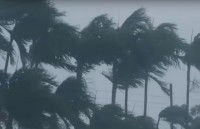Territorians urged to prepare for all weather hazards this wet season
08/10/2018

The Bureau of Meteorology released its tropical cyclone outlook today, reminding Territorians to start preparations for the severe weather season.
The outlook predicts slightly fewer tropical cyclones than average this year, which means we are likely to see two or three cyclones, of any intensity and size, form anywhere off the NT coast between November and April.
The Bureau's NT Manager, Todd Smith said that last year was an average tropical cyclone year, with nine cyclones in Australian waters.
"Although we saw the average number of tropical cyclones last season, most Darwinites would agree, after experiencing Tropical Cyclone Marcus, that it was far from an average season.
"It's important to remember that a typical wet season brings significant impacts from all weather hazards across the entire Territory. Tropical cyclones bring damaging winds and storm surges, with heavy rainfall and flooding, but we also see widespread impacts including flooding and strong winds from tropical low systems and severe thunderstorms right across the NT," Mr Smith said.
Northern Territory Emergency Services Director, Jason Collins agreed.
"The Bureau and NT Emergency Services are ready for whatever the coming season can throw at us - it's a core part of our business. Now is the time for Territorians to make sure they’re ready too.
“Territorians need to prepare for the coming season. While we have a highly capable emergency service, there is also a responsibility upon individuals to make their own preparations well in advance of any significant weather events.
“Having a Household Emergency Plan is a great place to start in terms of preparation. Discuss with the members of your household, including children, what they will do in an emergency or disaster. Answer these questions: What are your plans for when family members will be and will not be home? Where will you shelter? Is your yard clear of loose material that could become a dangerous projectile during extreme winds?” Mr Collins said.
Mr Collins advised that it can take up to 72 hours for help to arrive after a significant event.
“Ensure you have an up to date emergency kit, and that your kit is able to sustain you and each member of your family for three days or more,” he added.
The Cyclone Outlook is calculated by taking into account the influence of various climate drivers which suggest a possible El Niño later this year. When Australia has been in an El Niño regime in the past, there have been fewer than average tropical cyclones in the Australian region.
The Bureau encouraged the community to always listen to advice from the NT Emergency Services and the check the latest updates via SecureNT.nt.gov.au. Know your weather. Know your risk. Get all the latest forecasts and warnings at bom.gov.au, the BOM Weather app, or via Twitter at @BOM_NT.
Further information:
- Tropical cyclone warnings and information www.bom.gov.au/cyclone
- All severe weather warnings including flood http://www.bom.gov.au/nt/warnings/
- Household Emergency plans and other preparation information http://www.securent.nt.gov.au
- General information and videos about tropical cyclones www.bom.gov.au/cyclone/about/
- Updates on the El Niño Southern Oscillation www.bom.gov.au/climate/enso
- Northern Territory Emergency Service planning information http://www.pfes.nt.gov.au/Emergency-Service/Public-safety-advice/Household-emergency-planning.aspx










